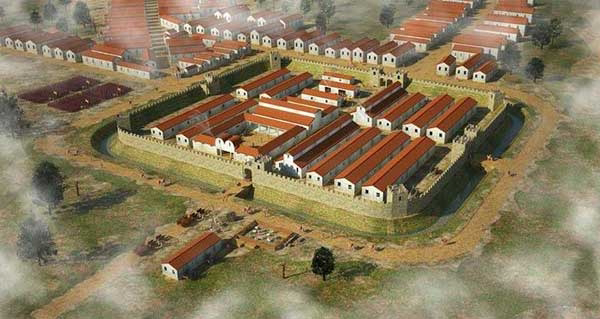Ribchester Roman Fort
My previous blog post (https://mistshadows.blogspot.com/2024/10/illtud-knight-rides-again.html) was, essentially, an acknowledgment of defeat, for I have unable to shake off what seems incontrovertible evidence supporting an identification of Uther with St. Illtud.
I've never much liked the Uther =Illtud equation, and for the many reasons I've previously expressed. I have from time to time supported the idea that Illtud the Terrible Chief of Dragons had himself only been made into Arthur's father because he had been wrongly confused/conflated with Sawyl Benisel of Ribchester. This idea worked on many levels. Most importantly, it allowed me to retain Arthur's Northern battles. I was not forced to forsake the many clues provided by tradition which solidly placed the battles there. I did not have to throw my hands up in despair while trying in vain to conjure good arguments for situating the battles in the South.
In this present article I wish to briefly run through the case made in favor of Sawyl as Arthur's father with an eye towards determining whether the theory is truly valid.
We may begin by listing the Illtud/Uther-Sawyl "correspondences", such as they are:
1) If we go by a strict end-rhyme requirement for the MARWNAT VTHYR PEN, Uther claims to have been transformed by God, 'Chief of the Lamp', into a 'second Sawyl (Samuel).'
2) In Illtud's Vita, his men raid St. Cadoc's monastery and are punished for the sacrilege; but in Cadoc's Vita, it is Sawyl's men who commit the misdeed.
3) In Geoffrey of Monmouth, Eldad/Illtud uses the Biblical Samuel as a model for action against the Saxons.
4) Uther is master of Mabon. Maponus was worshipped at Roman Ribchester. Llansawel, the Church of Sawel, has within its parish the fort of Mabon the Giant. Illtud's Llantwit Major is only a very short distance from Gileston, anciently called the Church of Mabon of the Vale.
5) Uther's son Madog and grandson Eliwlad may well be a reflection of Sawyl's son Matoc Ailithir. Cf. an Eli-(g)wlad construction with Aili-tir. Name and epithet would both mean 'Other-land.' In Irish, Ailithir means "pilgrim", i.e. a person from another country.
That is all from memory, of course. There may have been some other fine points to the argument that are lurking somewhere in the many blog posts I've created on the subject.
Now onto the memorial stone of L. Artorius Castus...
Several years of intensive research involving communication with the top scholars has shown conclusively that the fragmentary ARM[...]S of the Castus inscription could stand for either ARMENIOS or ARMORICOS. Both are equally possible.
In support of ARMENIOS is our knowledge of the Roman governor of Britain, Statius Priscus, being sent to command the army that retook Armenia, as well as the probable early date for the foundation of Castus's Liburnia.
In favor of ARMORICOS is knowledge of the Deserters' War in the reign of Commodus being centered in Gallia Lugdunensis, the proximity of Armorica to Britain, and the march to Rome against Perennis of the 1500 British spearmen. The force described by Dio exactly matches in number what we would expect from three legionary vexillations - like those found on Castus's stone - and this force is the only one of its kind mentioned in the sources for the time period we are considering.
ARMORICOS is necessary for a Ribchester Arthur, as that firt housed the Sarmatians, both as garrison troops and later as settled veterans. Armenia would mean Castus was in Britain before the Sarmatians arrived there. Armorica means he could have used Sarmatian troops in Britain and perhaps even on the Continent. For his Artorius name to have been preserved at Ribchester, he would, therefore, have had to fight in Armorica, not Armenia.
Now for what I have chosen to call "The Irish Problem"...
Whenever we deal with a historical Arthur of the early to mid-6th century, we must be able to account for why the name crops up again ONLY in two Irish-descended dynasties in Britain, viz. those of Dyfed and Dalriada.
Thus far, no one has been able to explain this fact.
Now, Sawyl of Ribchester, as it happens, married a princess who hailed from NE Ireland. Her kingdom had ties with Dalriada, and Arthur of Dyfed killed a member of a tribal group who were enemies of this particular kingdom. The Dalriadan royal family brought a British woman into its fold. I have explained the particulars of all this elsewhere. All I need say here is that an Arthur originating from Ribchester and achieving a high degree of fame in the North, and himself being noble Irish on his mother's side, may well have endeared himself reputation and name-wise to fledgling Irish principalities in Britain who were trying to emphasize their "Britishness."
CONCLUSION:
Sawyl Benisel of Ribchester is the best candidate for Arthur's historical father that I can come up with. Many will not be satisfied with my having arrived at this decision. But that is merely a symptom of the sad state Arthurian Studies has found itself in of late; no one is satisfied with a theory unless it is their own. Unique ownership of personal truth is paramount. The real truth thus remains elusive.
To once again quote Montaigne, "We most firmly believe that which we least know."


No comments:
Post a Comment
Note: Only a member of this blog may post a comment.